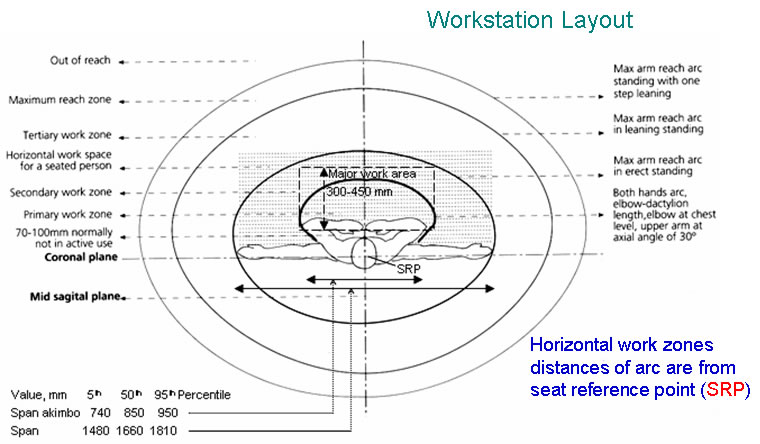Shakshat Virtual Lab

INDIAN INSTITUTE OF TECHNOLOGY GUWAHATI
|
|
||
|
Content
|
Horizontal work surface at around elbow height
|
|
| Theory | ||
| About experiment |
Most of the musculo skeletal disorders and some other occupational health problems are due to bad postures adopted while working as well as in one's daily life. The more one neglect this, the more one has to suffer and it becomes a chronic problem.
The most of the common work surfaces are horizontal and in some cases vertical or slanting in various degrees, and a combination of all these types, are seen in daily life. On a horizontal work surface, the nature and importance of work, the attention to be given to |
the task, the layout with arm reach limits, well defined work zone area should be specified. The primary work zone of a single person working at a table would be the area in front of the table, i.e., the 50th percentile of the span akimbo distance, so that he can perform his normal reading, writing, or even dining without any hindrance. For normal seating clearances in sitting arrangement in a row the same may be considered. Horizontal work surfaces may have an upward slope of 0 to 15 degrees and sometimes different heights also.
|
| Procedure | ||
|
|
||
|
The animated experiment provided here in aims at understanding the various horizontal work surfaces are in effect in our daily life, may be the office table, kitchen platform, console or any interactive work counter and various work component layout there in. Various work area covered by respective arm reach limits defines different work zones e.g., primary, secondary, and tertiary. This experiment acquaints with various horizontal work zones with the reference data set in Indian population context in various ranges of percentile values and respective ratio value between parameters and height.
|
||
|
<Back to content>
|
||
About experiment
|
||
|
This Study aims at understanding relevant arm reaches at horizontal surface for a seated person. Standing posture at(around) elbow label.
|
It also involves measuring techniques and equipment used and to provide some reference for workspace design purposes.
|
|
|
The presentation acquaints
|
||
|

|
|
|
<Back to content>
|
||
Procedure
|
||
|
Measuring procedures
Both direct and indirect measuring procedures are followed to collect anthropometric data from selected subjects; it may be done separately or both taken consideration simultaneously, depending on the context of the dimensional requirement and the suitability of the study.
Measurements can be done using photographic methods, using still photography and filming the whole body and or parts from different angles how people used to perform their daily activity on the horizontal work surface, the nature and the importance of work, how much attention is given to which task, their arm reach limits and accordingly work zones are specified. |
Dimensions are also measured creating a physically simulated work condition and subjects are asked to do the movements as originally is expected to be done.
For general requirement, Primary work area should be considered by taking the measurement of 50th percentile of the span akimbo distance, so that one can perform his normal activity like reading, writing etc without any hindrance; to get easy reach consider lower value of any reach dimension and to avoid reach towards ensuring safety, the higher values and sometimes additional clearances may be considered. |
|

|
||
| <Back to content> | ||
